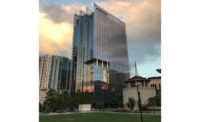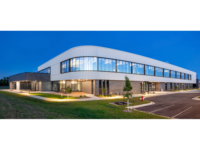When Bridgestone Americas Inc. designed its new tech center in Akron, Ohio, the company had a lot to live up to. After all, the site has been a center of innovation for more than a century, ever since Harvey S. Firestone founded the Firestone Tire and Rubber Company there in 1900. The company’s iconic headquarters and tech center was built in 1911 and became part of Bridgestone Corporation when it purchased the company in 1988. But having the tech center within the 100-year-old manufacturing facility was proving inefficient, and it was time to find the tech center a new home. The company wanted to consolidate its computer system, product development lab, and compound development operations in a stand-alone building that would house 450 teammates.
The budget, schedule and design goals for the new building were ambitious. The company broke ground on the $100-million project in April 2010 and held the dedication ceremony for the completed project in April 2012. Besides being the ideal site for the research and development team, the building had to meet several other goals, including reducing energy usage and employing green building materials and practices. It also had another purpose: to serve as a showcase for Firestone Building Products’ systems. Firestone products were used on the roof and throughout the building envelope to meet green goals and embody the company’s commitment to achieve a watertight, durable, integrated building envelope.
DESIGN GOALS
|
The exterior walls of the Bridgestone Americas Technical Center feature an array of different systems from Firestone Building Products, including:
The interior also contains 1,249 square feet of LS-1 Light Shelves, which were installed opposite the sun screens. |
“The building had to say, ‘advanced tech center,’” says architect Robert Marshall, SoL Harris/Day Architecture, North Canton, Ohio. The goal was to create an aesthetically pleasing structure that was coordinated with the other buildings to give the complex campus-type feel. The limited color palette, featuring stainless steel, red, and wood, also ties in with the corporate logo. In a nod to the company’s history, the lobby features an actual Firestone-sponsored IndyCar mounted to the wall.
Marshall noted that other key design concerns included interesting exterior views and the use of natural light to convey a sense of openness. “Another goal was to have a lot of informal meeting spaces, even in the atrium,” he says. “We wanted it to be open, transparent, comfortable.”
Making sure the building was green and sustainable was a focus for Bridgestone as well, and the building was designed to achieve LEED Gold certification and qualify as a RoofPoint Registered Project. Inside, low cubicles and interior glass, along with light shelves and a daylighting system with photo sensors, make the best use of natural light. Manual and automatic shades were installed on sunny exposures.
The roof systems were designed to increase energy efficiency. A prominent focus is the garden roof on the second level, which is visible from within much of the building.
UP ON THE ROOF
There were several roof areas involved in the project. Sections of UNA-CLAD metal roofing, SunWave Daylighting Systems and photovoltaic panels complement the two main roof systems—a fully adhered EPDM system and the garden roof assembly.
The main roof, penthouse and bridge are topped with Firestone’s 090 RubberGard EcoWhite Platinum EPDM, which is fully adhered to one layer of Firestone ISOGARD HD Coverboard. Below that are two layers of 2-inch Firestone ISO 95+ GL insulation, which were mechanically attached to the steel deck with heavy duty screws and insulation plates. Tapered ISO 95+ insulation was used for saddles and crickets.
Chris Tobias, Building Envelope Solutions Manager, Firestone Building Products, worked with accountants to set the budgets and determine the type of materials used on the project, then worked with the designers to ensure they were specified and installed correctly. Goals for the roof included reducing urban heat island effect and improving storm water management, but there was another key concern: durability.
“In terms of sustainability, it’s vitally important to ensure that roofs aren’t unnecessarily replaced,” says Tobias. He noted the roof systems have 30-year Platinum warranty, which is in line with the green goals on the project. He noted the warranty even covers damage from hail and punctures, like those that might result from an HVAC technician dropping a door from an air-handling unit, for example. “What we’re trying to do is encourage everyone to report these leaks so we can help them understand roof access and how you can prevent these problems from happening,” he says.
Tom Averitt, President of Advanced Building Products, was the local Firestone rep on the project, and he worked closely with the installing contractor, Gary Nusbaum of Wooster Roofing and Construction Co. in Akron.
Averitt noted the project also demonstrates the commitment Bridgestone has to all of its subcontractors. “It’s a high-profile project,” he says. “It’s important for Bridgestone overall. We wanted to support what our business is all about—the entire building envelope.”
Averitt and Nusbaum cited the details and flashing as the most critical components of the system—especially under the garden roof. Beneath the vegetative system is a black 90-mil RubberGard EPDM membrane with a 45-mil sacrificial layer on top of it. It also has a 30-year Platinum warranty.
ON THE WALLS
|
The Bridgestone Americas Technical Center was designed to be a green and sustainable site that would achieve LEED Gold certification and qualify as a RoofPoint Registered Project. Green concepts for the site and the building included:
|
The sides of the building feature an array of different wall panels, including an aluminum panel rainscreen system and flat-lock stainless steel wall panels with a specialized finish. Aluminum soffit panels and column covers give it a unified look. Matching sun screens and light shelves on the southeast side of the building were designed to make the best use of natural light and tie in with the daylighting system.
Marshall indicated they originally considered zinc and anodized aluminum for the wall panels, but decided they would look harsh in bright sunlight. They decided on painted aluminum and stainless steel with an embossed pattern. “The embossed pattern softens the reflectivity and doesn’t make it look so harsh,” he says.
Tobias explained that substrate preparation was crucial, so 3-D modeling was used to make sure everything was square and plumb. The installing contractor was Thom Geist of the Geist Co. in Cleveland, Ohio. The wall panels were lifted into place by four men with two snorkel lifts, working in concert. “It was a smooth installation,” says Tobias. “Making sure the substrate is true is the key.”
A CATALYST FOR INNOVATION
The Bridgestone Americas Technical Center project was completed on time and under budget.
Gary Garfield, CEO and president of Bridgestone Americas said, “When I look at that building, I look at a catalyst for innovation in the future.” W&C









